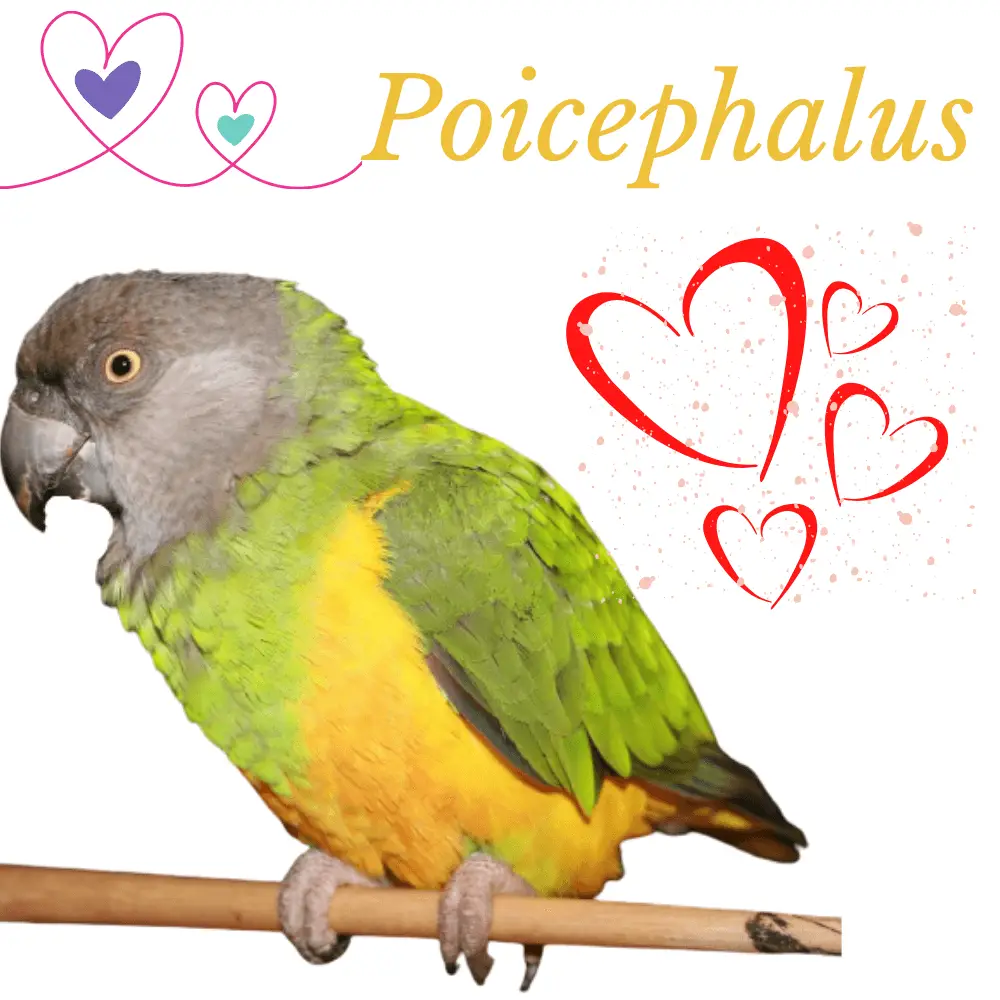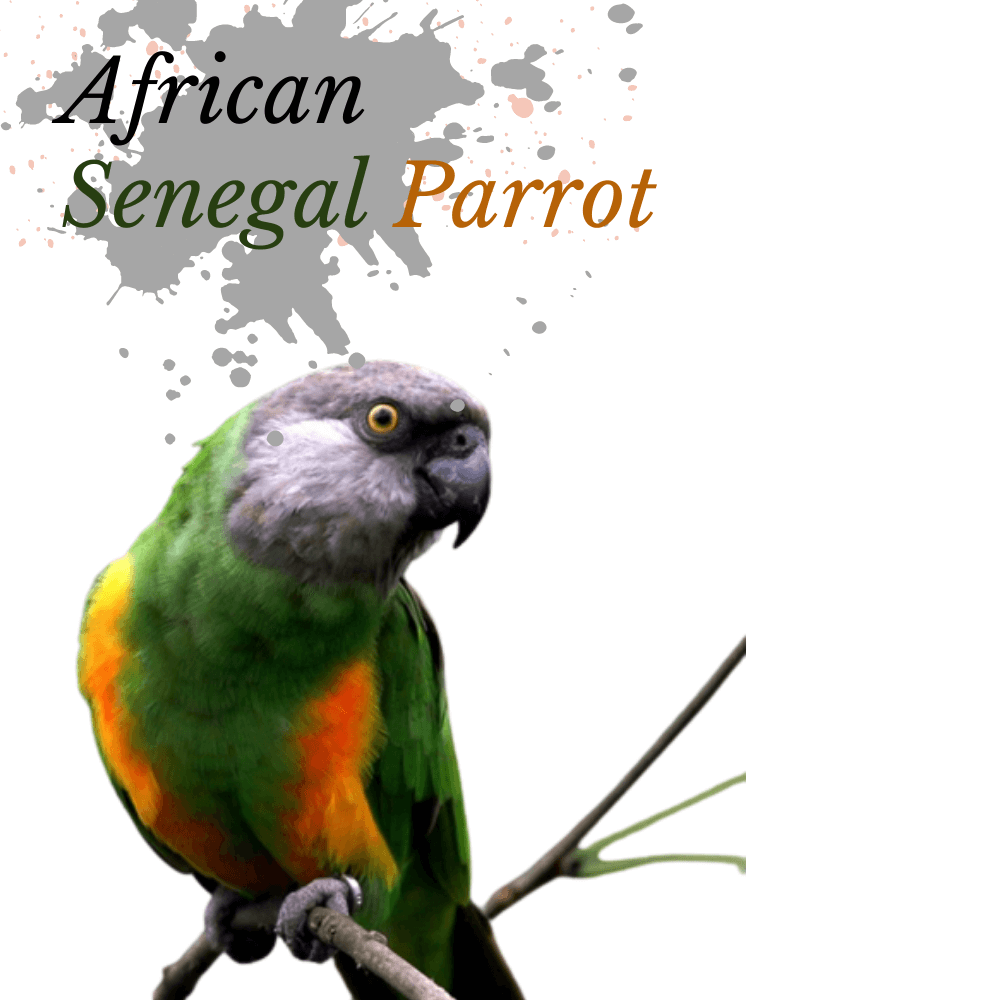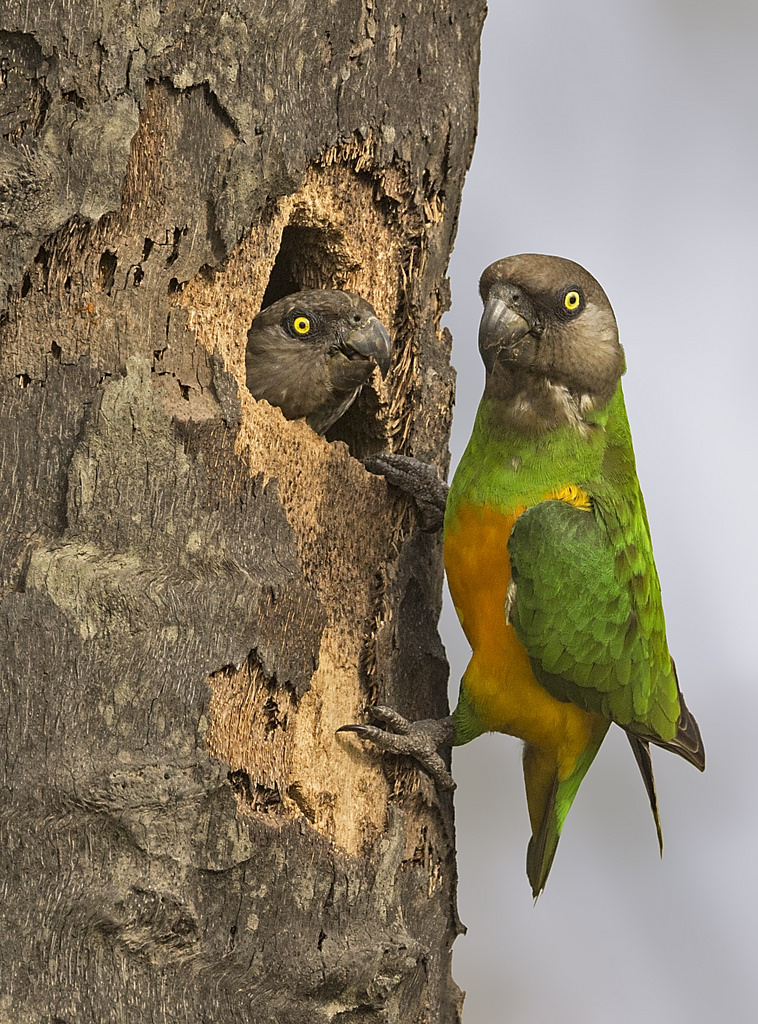
The Poicephalus senegalus or Senegal parrot also called Youyou from Senegal, is a small species of African parrot (20 to 26 cm) belonging to the genus Poicephalus, with colorful plumage. The head is gray (cheeks often silver), the body is green, the wings and tail duller and the belly yellow, orange, or red, according to the three different subspecies:
Poicephalus s. yellow-bellied senegalus, the most widespread;
Poicephalus s. orange-bellied mesotypus;
Poicephalus s. red-bellied versteri.
Hybrids between subspecies are also quite common.
Although only the DNA test is 100% reliable, we can sometimes differentiate the male from the female by looking carefully at the color of the underside of the tail:
entirely yellow: a male,
entirely green, green, and yellow: one female.
Are Senegal parrots friendly?
How much is a Senegal parrot?
How big do Senegal parrots get?
Order: Psittaciformes Famille: Psittacidae
Régime juridique: CITES Appendix II, free quota holding
Sexage: No sexual dimorphism
Phenotype:
- Very colorful parrot with a gray head, green collar and back, red-orange belly, and dorsal side of green wings
Character: Bird is very playful and very pleasant, asking for maintenance but which may be suitable for a beginner. Very good noise imitator he can also be able to pronounce some words. Sociable parrots are relatively can noisy and do not tend to hyper-attachment.
Weight: 120 – 160g

Senegal Parrot
SOURCE:Love of Pets
The Poicephalus or Senegal parrot is the real star of pet birds. They are very popular, kept around the world. This enthusiasm is justified, they are fabulous little parrots, with a playful personality, full of affection, fun, friendly, and of great intelligence.
Senegal parrot personality
The Senegal parrot personality is generally very nice when they are well socialized. A proportionately large cage is necessary because they are real clowns, specialists in acrobatics of all kinds.
Origin: Africa
Size: 20 to 25 cm
Legal status :
Annex 2 Cites
Poicephalus are loyal, loyal, and able to bond very quickly with a human. Too quickly sometimes, and too loud! They are known for their jealousy of family members and other pets. Especially since they are afraid of nothing and do not seem aware of their size. There is absolutely nothing to worry about facing a big dog; in short, they are quite exclusive and can refuse to interact with others. This behavior can be avoided by socializing the bird from an early age and relentlessly. Young Poicephalus are relatively adaptable to new environments and new experiences. We must, therefore, take advantage of this period to make them meet many people
Senegal birds are curious, playful, and love to have attention and caresses. However, these birds are more independent than the average parrot, which makes them particularly easy-going birds.
African Senegal parrot

Be careful, they tend to become more independent, even shy and cheeky at the time of sexual maturity, ie at the age of 2 to 4 years. It is a behavior to anticipate by creating a real balanced relationship, by allowing a maximum of time out of the cage, by promoting games, exchanges, training with as many different people as possible.
These birds love to play, so enriching their environment is essential. Branches, pieces of wood, toys are essential. Their voices are known to be soft and pleasant, which makes them particularly suitable for living in apartments. They are obviously able to shout and make noise, but not loud enough to disturb.
Poicephalus parrots
SOURCE:Discover PARROTS
REQUIREMENTS
he main thing for these birds is socialization, exchanges with many different people. This is a very important point to avoid exclusive or overly independent behavior. Toys and a cage to express their acrobatic skills are necessary, but overall they are easy-going birds.
SUGGESTED FOOD FOR Poicephalus or Senegal parrot
Poicephalus, like their African cousins, appear to be more susceptible to calcium deficiency than other parrots. It is, therefore, preferable to distribute more balanced extrudates rather than a simple mixture of seeds. Otherwise, add a pinch of powdered calcium to fruits and vegetables. For the rest, there is no special requirement
THE IDEAL FAMILY
If you are well socialized, Youyou are easy to live with, and particularly adaptable during their young age to all kinds of situations. They are really nice, smart and loyal, and a single person like a large family will be suitable. With these real stars, life is not quite the same …
Senegal bird

SCIENTIFIC NAME
Poicephalus senegalus
ORIGINS
Africa. Wooded and arid savannas, as well as open forests.
ADULT SIZE
23 cm
VARIETY
Conures are a very large family of parrots.
Senegal parrot lifespan
The average life expectancy of The Youyou of Senegal is between 25 and 30 years.
SEXUAL DIMORPHISM
The underside of the tail is yellow in the male and green in the female. To be sure, sexing with a DNA test is in order.
SONG
Bearing voice and certain will learn to say words.
REPRODUCTION
Breeding in captivity is fairly easy. The female lays 2 to 3 eggs, which she incubates for 28 days. Weaning is around 9-10 weeks. The nest box must be 25 x 25 x 25 cm with a 6 cm diameter flight hole.
SOCIAL BEHAVIOR
The autonomous bird that likes to play. He is active, so provide him with safe games and toys.
He must be well socialized to avoid an exclusive attachment because he can be jealous in nature.
FOOD
A mixture of grains for conure, mash (tropican), pasta, rice, brown bread
vegetables: spinach, broccoli, cucumber, squash, broad beans, alfalfa
fruits: apricot, banana, melon, peach, pear, grapes.
EXTRA CHARGE
Vitamin, mineral, and amino acid concentrate supplement (Prime).
How to train your senegal parrot
SOURCE:MARLENE MC’COHEN
The cage should be large enough for him to flap his wings and play at ease. The spacing of the bars should not allow the bird to pass its head. Preferably, a rectangular cage is chosen. We install the cage in a corner (if possible) and away from cold drafts. One shower a day and 10-12 hours of uninterrupted sleep are also recommended. It requires claw and wing pruning (if desired) every 2 months. Like all birds, it requires a cuttlefish bone to get the calcium it needs.
TO AVOID
Parsley, beet greens, raw potatoes, avocados, cooked onions, seeds, pits, alcohol, caffeine, sugar (chocolate), salt, spices, Teflon, lead, mercury, zinc, household products (Swiffer, Glade plugged into the wall, etc.) .), incense, scented candles, nicotine. Cold drafts are also very harmful to the bird.
NECESSARY ITEMS
- A cage of at least 16 “x 14”
- A cuttlefish bone
- Millets
- Food
- Toys
- A mineral block
- Substrate (wood pellets)
- Perches of different materials
- Vitamin and amino acid supplements




















